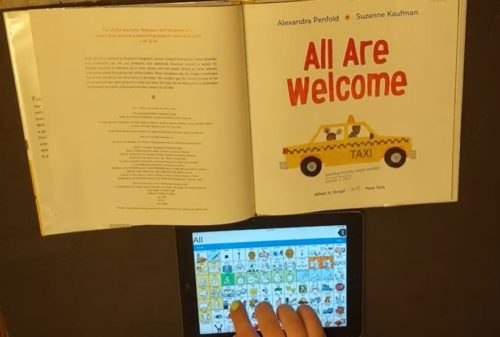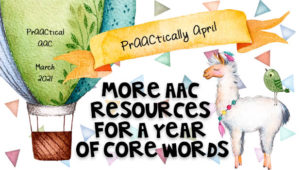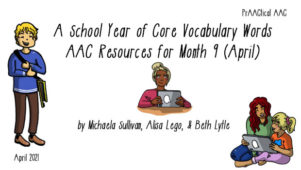TELL ME About It: AAC Learning with ‘All Are Welcome’!
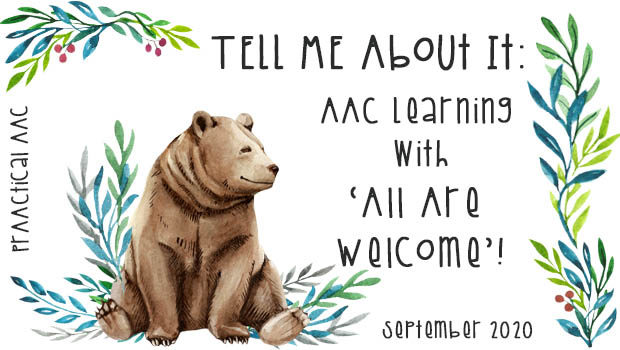
Welcome to Year 2 of the TELL ME About It series, guest authored by Jeanna Antrim and Maggie Judson. For the past year, they’ve written monthly articles to discuss how they support preschool teachers who are implementing the TELL ME program with their young students. Maggie and Jeanna are speech-language pathologists who work in the Assistive Technology Department for the Belleville Area Special Services Cooperative (BASSC) in southern Illinois. They are AT/AAC facilitators and provide evaluations, direct therapy, consultations, and trainings with school teams.
In Year 1 of this series, Jeanna and Maggie focused on the 11 books in the TELL ME program. In each of those posts, they shared a lesson plan, activity suggestions, video demonstrations, and much more. You can see their previous posts in the TELL ME About It series below.
- Max’s Breakfast
- If You’re Angry and You Know It
- The Lunch Box Surprise
- Come Out and Play, Little Mouse
- No, David
- Go Away Big Green Monster
- What Do You Like?
- Here Are My Hands
- From Head to Toe
- I Went Walking
- Brown Bear, Brown Bear
- TELL ME AAC Literacy Kits
The intent of the TELL ME program is for teachers, therapists, and paraprofessionals to build habits and instructional routines that support core vocabulary learning over the course of the 11 storybooks addressed in the program. Following that, teams should be able to take what they’ve learned and apply it to any book they want to read with their class.
In Year 2, Jeanna and Maggie will continue the series with books outside of the TELL ME program to help them move forward. Each month, they’ll share plans, ideas, and resources that teams can use to support the core vocabulary addressed in the TELL ME program. These posts are packed with ready-to-use resources for your in-person or teletherapy lessons, so don’t miss the links to video read-alouds, Boom card decks, Tarheel Game Play games, and lots of implementation ideas.
Let’s get started!
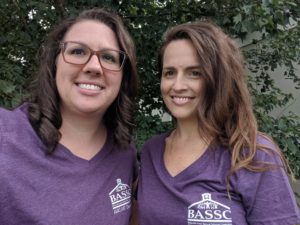
TELL ME About The Book
All Are Welcome by Alexandra Penfold
In this new series, the first book is “All Are Welcome” – an excellent read for this time of year, as the story follows a group of children going about a day in their school. We love this book for the storyline, colorful illustrations, rhyming, repeated lines, and core words. And if you think you recognize those core words below, it’s because you do! They are the same core words targeted in the TELL ME curriculum, and we will be working them all in with this new series because repetition with variety is where it’s at! 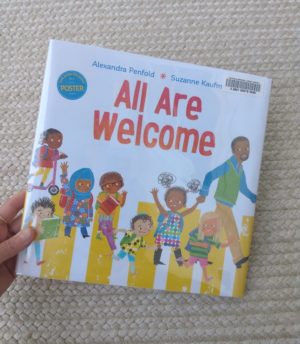
Book Focus: All Are Welcome
- Core Words (BOW WOW Words): ALL, HERE, YOU, BUSY
- Additional Words (Tiger Talk Words): hand, head
- Concept Vocabulary: school vocabulary (examples: pencil, bell, music, art)
- Book Concept: front of the book
- Special Letters: a, m, t, p, o, n, c, d, u, g
Now that we have gotten used to focusing on one special letter for each book through the TELL ME program, we are ready to move into targeting one letter per day. According to Erickson & Koppenhaver (2020), a letter-of-the-day approach offers more distributed practice for students at risk for literacy learning difficulties. And since TELL ME recommends using a book for two weeks, we will have ten letters to focus on (one per school day!).
TELL ME About Reading
Repeated Reading Focus: Make Comments (CAR)
Engaging in shared reading through repeated readings is the name of the game for our students with complex communication needs as they develop their emergent literacy skills. But how can we support our students as they develop this ability? The main thing it comes down to is, drum roll,…. us! “The language and literacy skills that are acquired during shared reading are the result of the ways that adults communicate with students while reading” (Erickson & Koppenhaver, 2020, pg. 51). So the good news is that by learning how to provide effective shared reading strategies, we can build our students’ language and literacy skills!
One structured way to achieve this is to learn to Follow the CAR. CAR is a teaching strategy that incorporates three steps:
- Comment and wait
- Ask for participation and wait
- Respond by adding a little more
The idea is to make a simple Comment, think five words or less, on each page after reading the text and then stop and wait (how long? It depends on the individual student, but a good rule of thumb is at least 10 seconds!) to allow students to respond or comment back. If the student doesn’t respond to your comment, Ask for participation by saying something like, “Tell me what you see in the illustration.” If a student then makes a comment, Respond by repeating back what they said and adding a bit more to increase the complexity. And if they don’t respond? Keep reading! Move on to the next page and start the CAR cycle again. This strategy is not about asking questions, but keeping the focus on building engagement and interaction, with the ultimate goal being for your students to begin to lead the shared reading interaction.
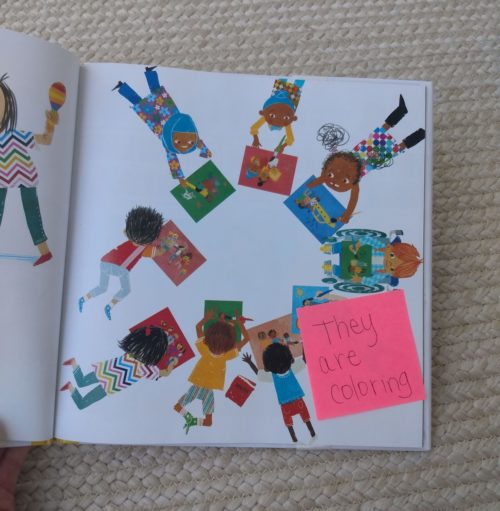
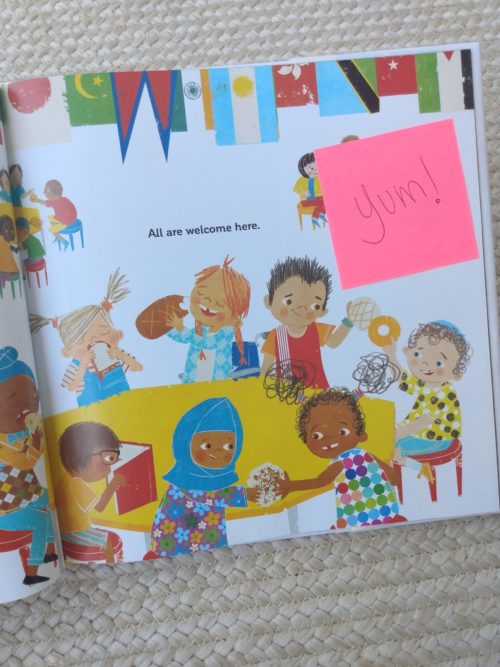

To learn more about CAR, check out this training module from Tar Heel Shared Reader.
Adaptation Idea: Enlarge Text
Taking the time to adapt a book can have a big payoff during your shared reading interactions. But by thinking through what specific adaptations your students and caseload need will provide even more of a benefit! There are so many different ways you can change a book to make it more accessible for a student, but not every student is necessarily going to need every modification. Thinking about what your students specifically need to be modified in a book to help them access it while keeping your prep time manageable.
One beneficial book adaptation that you could consider is enlarging the text. Enlarging text is a simple way to adapt a book – write or type the text of each page on an index card or piece of paper in a large font (20 pt font or larger) and place it on the page. This type of adaptation may be appropriate for students who need extra help to focus on the text. And the bigger size can make it easier for you to provide text referencing – whether in person or via teleservices!
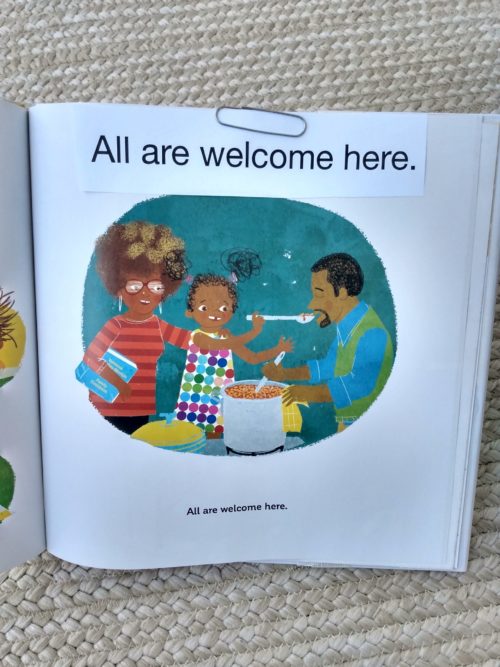
TELL ME About Writing
The TELL ME program incorporates a strong emphasis on shared writing, with a different writing activity completed each day. Including writing instruction for students with complex communication needs may on the surface sound hard to plan for and implement, especially when thinking of our youngest students. But the TELL ME program does a great job of breaking each step of shared writing down into individual, easy-to-implement lessons and activities. For us, as educators, learning to provide high-quality literacy instruction to students with complex communication needs doesn’t necessarily develop naturally. We require clear guidance and repeated practice to learn – just like when our students learn a new skill! And what an important skill writing is! Writing is a complex process, and the more chances children have to practice, the better! Including writing opportunities daily in the preschool classroom can help our students progress in their emergent literacy development.
So as you journey into new books outside of the original TELL ME curriculum, take these lessons learned and apply them when planning out writing instruction for your students. Every month we will share a predictable chart topic, in keeping with the examples from the TELL ME program, and give some ideas to work the FUN in FUNctional for different writing activities!
Predictable Chart Topic 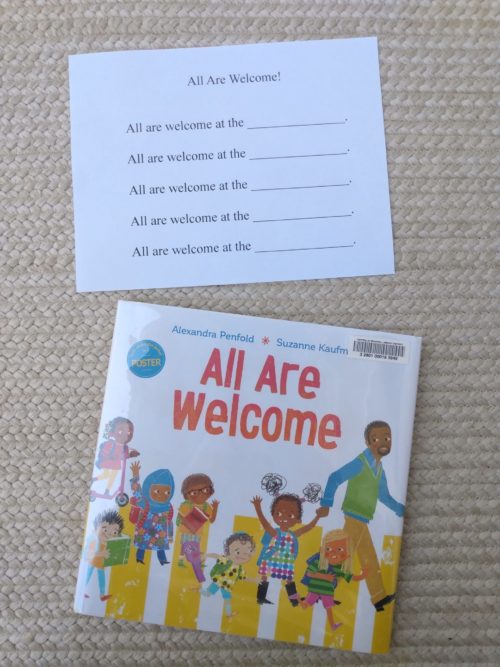
Title: ALL Are Welcome!
Sentence frame: ALL are welcome at the ___________.
FUNctional Writing Activity
A typical writing activity for students in the preschool classroom is writing their name, but there is no need to keep name writing to center time only. Work it in throughout the day in natural, meaningful ways to give students even more writing experience! Some ideas:
- sign-in during morning meeting
- sign up for daily jobs
- voting for activities or favorite items
- writing names on art/craft projects
- sign up for snack preference
TELL ME More
Below are some specific ideas on how to implement “All Are Welcome” in your therapy sessions and classrooms TELL ME-style!
Aided Language Input Tip – Creating a Successful Communication Atmosphere for the School Year
Many students who enter into a preschool or early childhood special education classroom who could benefit from AAC strategies do not have a specific AAC system in place. Which can present a challenge for both the student and the communication partners. But, by introducing manual communication boards as classroom-wide support, you can provide an effective and fast way to get the needed language and communication supports in place. And it offers easy access to AAC supports for all activities throughout the school day!
Using low-tech AAC systems during shared reading and shared writing instruction can help get a solid foundation started for incorporating AAC in various parts of the day. From there, integrating these visual communication supports in other activities feels totally doable! Language and literacy learning happens all day long, so by providing AAC supports and systems all day long, we support our students as they develop these skills.
Having manual communication boards available in multiple locations in the classroom makes it easier to teach and practice language and literacy skills in all sorts of activities.
We like to think of it in terms of the 3-second rule. Suppose you are not able to get access to communication support within 3 seconds. In that case, you are not going to be able to provide AAC and aided language input fast enough to take advantage of a communication opportunity (read more about the 3-second rule here). So the more AAC, the better! Here are some examples of how to provide AAC all day:
- Manual communication boards taped to desks allow for easy access to language during snack time, centers, and crafts.
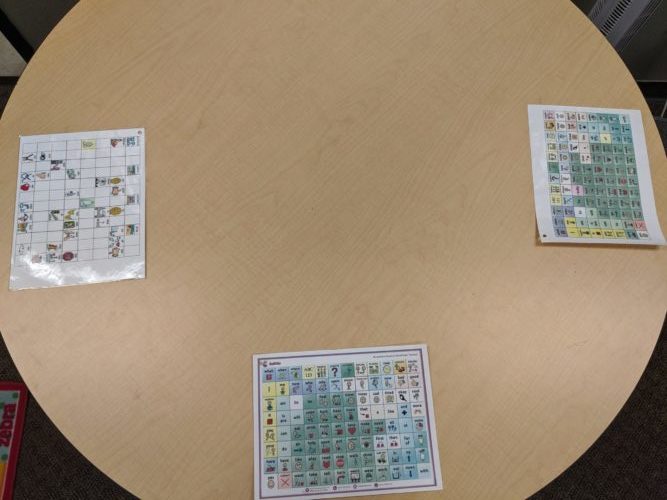
- Having boards on teacher lanyards provides support on-the-go when walking in the hallway during transitions.
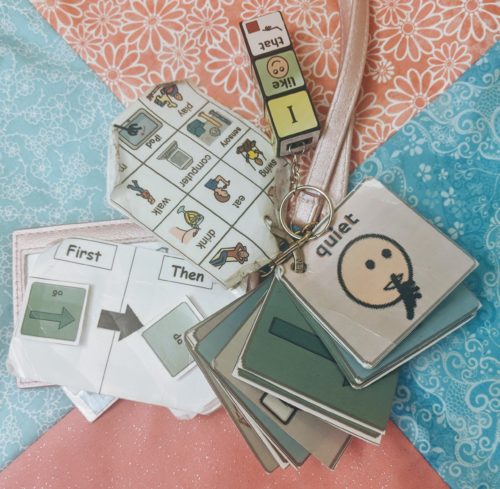
- Keeping a board next to the toys allows any staff member to provide communication support during play.
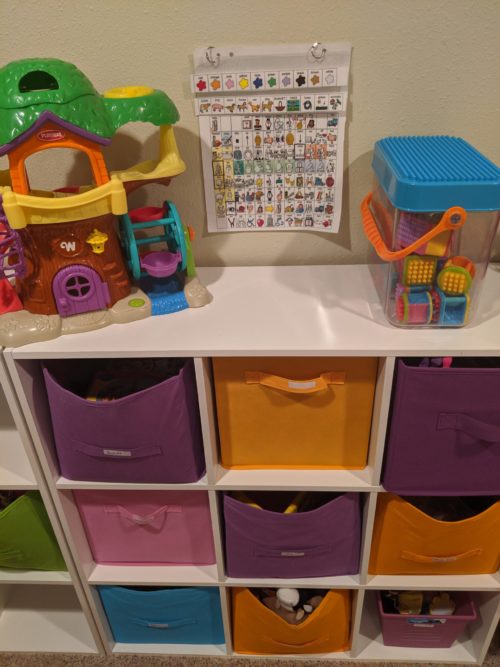
Embedding Core into the Daily Routine – Arrival/Departure Time
Arrival and departure time is such a routine-based activity within the classroom, making it a natural time to incorporate those core words into different rote phrases and scripts. Having some predetermined scripts can be a supportive way for communication partners in the classroom to become comfortable with targeting core words and providing aided language input on AAC systems.
Some examples for arrival:
- “Yay, YOU are HERE!”
- “Did YOU have a BUSY morning?”
- “Put ALL your things away.”
- “Oh look, YOU have a hat on your HEAD!”
- “Let’s go wash our HANDs.”
Some examples for departure:
- “It’s time to HEAD home!”
- “School is ALL done for today.”
- “First we need to wash our HANDs.”
- “We had such a BUSY day learning!”
- “HERE, let me HAND YOU your backpack.”
- “Can’t wait to see YOU HERE tomorrow!”
Data Collection idea – Beyond +/-
While data collection may not be the most fun thing to do in our AAC and literacy-loving day, we know its importance. Collecting information and analyzing it helps us understand how our students are progressing, what things we need to change or modify to support their growth, and helps us see where we want our students to go in terms of their skills. And we don’t know about you, but we are always looking for a good data collection tip to help us take even more information beyond just a +/-!
When collecting data, it can help to gather information regarding what level of support or prompt was used for each response. We learned in the POWER: AAC modules from the Pennsylvania Training and Technical Assistance Network (PaTTAN) and Gail Van Tatehhove, to use the following notation to indicate how the student responded:
- X = opportunity provided, but not taken
- B = behavior (ie, laugh, reach)
- V = vocalization/speech
- G = gesture
- S = symbol on a communication system
- / = no opportunity provided
To learn more, check out the POWER: AAC module 11, Collect Evidence, here.
Virtual Learning Resources – Speech Without Limits & The Bookish SLP
As we learn more about and start to settle into a kind of routine with telehealth, incorporating virtual learning resources is becoming the norm. Every month we will share a resource that we are loving and finding helpful and talk about ways to use it to incorporate the core word, language, and literacy focus for the target book.
This month, we wanted to share the resources that we (Jeanna and Maggie) have available!
Jeanna, from Speech Without Limits, provides a ‘Core Vocabulary Words in AACtion’ video series on YouTube, demonstrating how to use core vocabulary words for different functions of communication. Check out the videos for the book’s target core vocabulary words: BUSY, ALL, YOU, and HERE. She also has a Boom Learning store and has Boom Decks available for HERE, BUSY, ALL and YOU.
Maggie, from The Bookish SLP, has virtual resources available for the word ALL. Check out a digital book activity you can use via Google Classrooms, a Boom Learning deck, YouTube videos, and Tar Heel Game Play videos (1, 2, 3), all about ALL.
These virtual learning resources can be used to offer repeated practice for the target core vocabulary words when providing telehealth services or shared with families to use at home!
TELL ME at Home
Setting Up Low Tech Communication Supports at Home
Supporting our students’ communication needs in the home has always been an important consideration for educators. And during this time of virtual learning, it is even more essential we help our families create a ‘TELL ME at Home’ environment.
One way we can support families is by helping them set up low tech communication supports in the home. Just like in the classroom or therapy room, having manual communication boards available in multiple locations in the house makes it easier to teach and practice language and literacy skills in all sorts of activities. Along with the ideas shared above for the classroom, some other ideas to send home to families:
- Manual communication boards printed on magnets – We do this through the Shutterfly app during their dollar deals (if you wait, you can get a magnet for only one dollar with free shipping!). Stick them on a fridge, on a door, take on a walk, stick on the car, or throw one in a bag (they are super sturdy and durable).

- Iron-on manual communication boards – You can iron-on boards on to shirts, bags, aprons, blankets, even a dog’s bandana (because isn’t the family dog ALWAYS around?!).
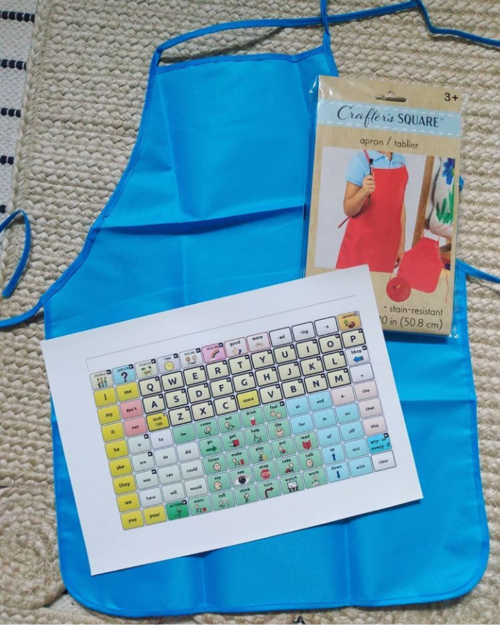
- Large, poster-size manual communication boards – Check-in with your device reps to see if they can help out with this, or print poster size if you need a custom vocabulary. These are great not only on the wall, but you can suggest families try putting it on the floor to play around with, taking outside for fun in the garden, and using it with the whole family to get everyone involved!
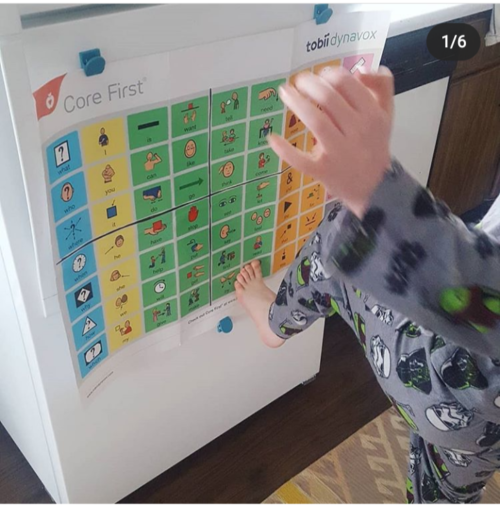
Self-Reflection Tip
General Overview
Although it can be uncomfortable (ummm, watching a recording of yourself conducting a lesson or therapy session… yikes!), self-reflection is one meaningful way to change and improve your therapy or instructional practice. When you take the time to ask yourself questions, you can more easily see what areas you are rocking and what areas need your attention. Taking the time to reflect can help you set priorities for yourself, and we promise that it gets easier the more you do it! The TELL ME program is all about helping us as educators develop good AAC teaching practices and routines that can then be implemented when planning other lessons. But to do this, we have to reflect on how we are providing instruction. Self-reflection allows us to analyze what we are doing well and what we need to improve on. As the TELL ME program provides daily self-reflection forms, we will use this space each month to think through different areas to focus on to help us improve our practice.
———————————————————————————————————————
To read more about how we prepare for a TELL ME week, check out our previous posts in the TELL ME About It series!
Be sure to check back next month as we work through the TELL ME manual and share activities, teaching strategies and implementation tips for the next book in this new series, “I Know A Lot”!
Video Read-Alouds
Check out the videos of us reading the book “All Are Welcome Here” while providing aided language input:
- AAC Modeling All Are Welcome with TouchChat WordPower 60 Basic

- AAC Modeling All Are Welcome with Snap Core First 80 grid manual communication board
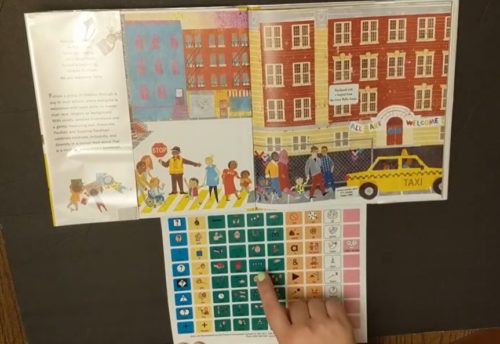
RESOURCES and REFERENCES
Erickson, K,. & Koppenhaver, D. (2020). Comprehensive Literacy for All: Teaching Students with Significant Disabilities to Read and Write. Baltimore, MA: Paul H. Brookes Publishing Co.
- You can purchase the TELL ME manual from the Attainment Company or from ASHA.
- You can learn more about the program by watching the webinar TELL ME: AAC for the Preschool Classroom presented by Dr. Carole Zangari, available from Saltillo (bit.ly/2RNpykn).
Follow us on Instagram @basscAAC and subscribe to our YouTube channel (basscAAC) for more AAC implementation ideas!
Filed under: Featured Posts, PrAACtical Thinking
Tagged With: core vocabulary, predictable chart writing, reading, TELL ME
This post was written by Carole Zangari
